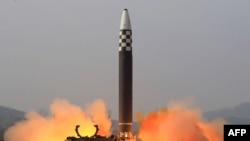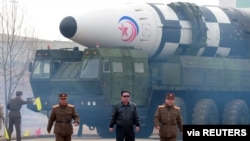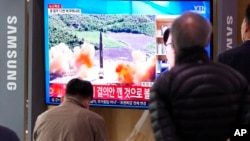North Korea’s long-range launch last week likely involved a missile it previously tested in 2017, not the new type of intercontinental ballistic missile North Korea claims to have fired, according to South Korea’s military.
The missile used in the March 24 test was likely a modified version of a Hwasong-15 ICBM, not the larger Hwasong-17 ICBM, a South Korean military spokesperson told VOA on Tuesday
Even if North Korea tested the smaller missile, it still may represent a technological improvement. Japanese and South Korean officials said the missile traveled further and went higher than any of North Korea’s previous ICBM launches.
North Korean state television last week released theatrical footage of leader Kim Jong Un personally directing what it claimed was the latest launch. The video included slow-motion clips and flashy edits of Kim, who wore a black leather jacket and sunglasses.
The footage instantly went viral, with online commentators noting Kim appeared to be mimicking “Maverick,” the main character in the 1986 Hollywood film “Top Gun.”
Almost as quickly, defense experts pointed to inconsistencies in the video, saying it appeared to include footage from a March 16 test of a Hwasong-17, which exploded shortly after launch.
North Korea has doctored missile test footage before. It has also claimed to have successfully launched satellites into orbit on occasions when outsider accounts indicated the satellites fell into the ocean.
However, this missile deception would amount to one of North Korea’s most brazen. The missile was launched from North Korea’s main international airport near Pyongyang. North Korean state media has touted its success, even posting pictures of Kim posing with hundreds of defense officials who participated in the launch.
It’s not clear why North Korea would feel the need to lie about which missile it tested. Though the Hwasong-17 is larger, even the Hwasong-15 can reach anywhere in the continental United States, U.S. officials concluded after its first launch in November 2017.
Defense analysts say the Hwasong-17 offers some advantages, such as its large size, which could enable it to carry multiple warheads, making it harder for U.S. missile defenses to intercept.
The imposing size of the Hwasong-17, dubbed by some experts as the “monster missile,” also may appeal to North Korean propagandists who produced last week’s dramatic state TV launch footage. However, the 15-minute-long feature also helped analysts uncover North Korea’s deception.
Colin Zwirko, who reports for the Seoul-based NK News, was the first to publicly observe irregularities suggesting at least some of the footage was from the failed launch that occurred more than a week earlier.
Among the most damning evidence: shadows in the North Korean footage suggest the launch was conducted in the morning, as during the failed March 16 launch, not in the afternoon, as during the March 24 launch.
While the presence of old footage did not prove North Korea was lying about which missile it tested, such claims were bolstered by subsequent reports. The Washington Post on Monday quoted an unnamed U.S. official who also said the missile appeared to be a Hwasong-15 that was modified to fly higher and further than it did in 2017.
However, Japan’s government continues to assess that the North fired a “new form” of ICBM, a spokesperson for the Japanese Prime Minister’s Office told VOA on Tuesday.
Park Won Gon, a professor at Seoul's Ewha University, also said he still assesses, based on public evidence, that North Korea launched the larger missile, even if the North’s state television did appear to use older footage.
If Kim were lying so brazenly about the launch, he likely would not have posed for a picture with those who participated in the test, Park said. “Probably more than a thousand people [would have had to] collaborate… I think this is practically impossible,” he told VOA.
Either way, North Korea’s ICBM launch significantly raised tension on the Korean Peninsula — and it may not be done yet. North Korea has also warned that it will soon launch a military spy satellite into orbit. U.S. intelligence officials believe North Korea could also conduct a nuclear test later this year, according to an assessment released earlier this month.



